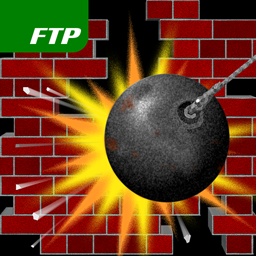Results show few opportunities for optimism.
When I wrote an earlier blog post, FTP: Early Results, I stated that it was too early to draw any conclusions from the very early data from Demolish! Pairs FTP. However, now that we have almost two weeks of data from Demolish! Pairs FTP on the App Store, the results are beginning to look more conclusive.
Day-to-Day Play-by-Play
Here is a rundown of the basic results since the app has been available:
Day 1: [baseline]
As previously reported, the first full day of downloads was Thursday, November 7, 2013, which provided more downloads, from 24 different countries, than we had sales of the “paid” version, Demolish! Pairs; therefore, I will use that number as the baseline figure for downloads (i.e., 100%) and all other percentages are relative to this figure.
Day 2:
On the second day, we did not do any additional marketing in order to determine the approximate natural fall off. The icon was no longer visible on either of the game category pages (and certainly not on the main game page). Downloads were at 72%.
Day 3:
We announced the release (again) on the Digital Gamecraft page on Facebook, this time using ‘Boost Post’ to promote the message to two countries, the United States (our biggest market) and Australia (an unrepresented English-speaking market). For $51.69, we “reached” 30848 Facebook users. Downloads: 64% (none from Australia)
Day 4:
We stopped the Facebook post promotion and allowed for residual effects to accrue, which they did by virtue of Australian downloads outpacing US by one. Downloads: 37%
Day 5:
This time, we tried a targeted Facebook ad, selecting for puzzle game players, in (6) English-speaking countries, who used iPads. (Oddly, I could not find a way to target only mobile users, so some views would be on desktop systems. 🙁 ) Facebook reports our total reach to be 50541 (about 3% of the selected audience). Downloads: 20%
Day 6:
After stopping this latest Facebook ad, there was an unexplained “blip” in the results, which could have been a residual effect. Downloads: 27%
Day 7:
With the slight increase in downloads on Day 6 (and, frankly, with other priority tasks), we decided to wait another day to see if the upward trend would hold. Unfortunately, downloads plummeted to the worst level yet: Downloads: 4%
Days 8 through 12:
Risking “zombification”, we left the game alone to simply observe. It continues to draw low levels of daily activity. Downloads: 4%, 3%, 6%, 4%, 2%
Three Strikes
Clearly, the download figures were destined to drop toward a minimal level, with the Facebook marketing making no discernible difference. However, there are three worse facts that make a big difference here.
First, although the number of iAd requests climbs steadily, the number of ad impressions is phenomenally low (as the fill rate remains below 3%), so advertising revenue is essentially non-existent; it has not yet eclipsed the $1 mark (total).
Second, despite the number of downloads, nobody has purchased any IAP product at all. The game is being played, as shown by the iAd requests, but the conversion rate is 0.0% as everybody plays only for free.
Third, the existence of a free-to-play version has cannibalized “paid” sales. Not only is nobody paying for any IAP, but sales of the original edition dropped to zero when the FTP edition was released, and it has not sold a single unit since.
Conclusions
Although I still have some things to try yet, my recommendation to anybody considering the mobile games market is not to waste any time on it. In fact, I would suggest that anybody who is looking to begin a career in game development right now strongly consider a different line of work entirely.
Note: This is blog post number 405, which is the HTTP status code for “Method Not Allowed“. Coincidence? You decide.

